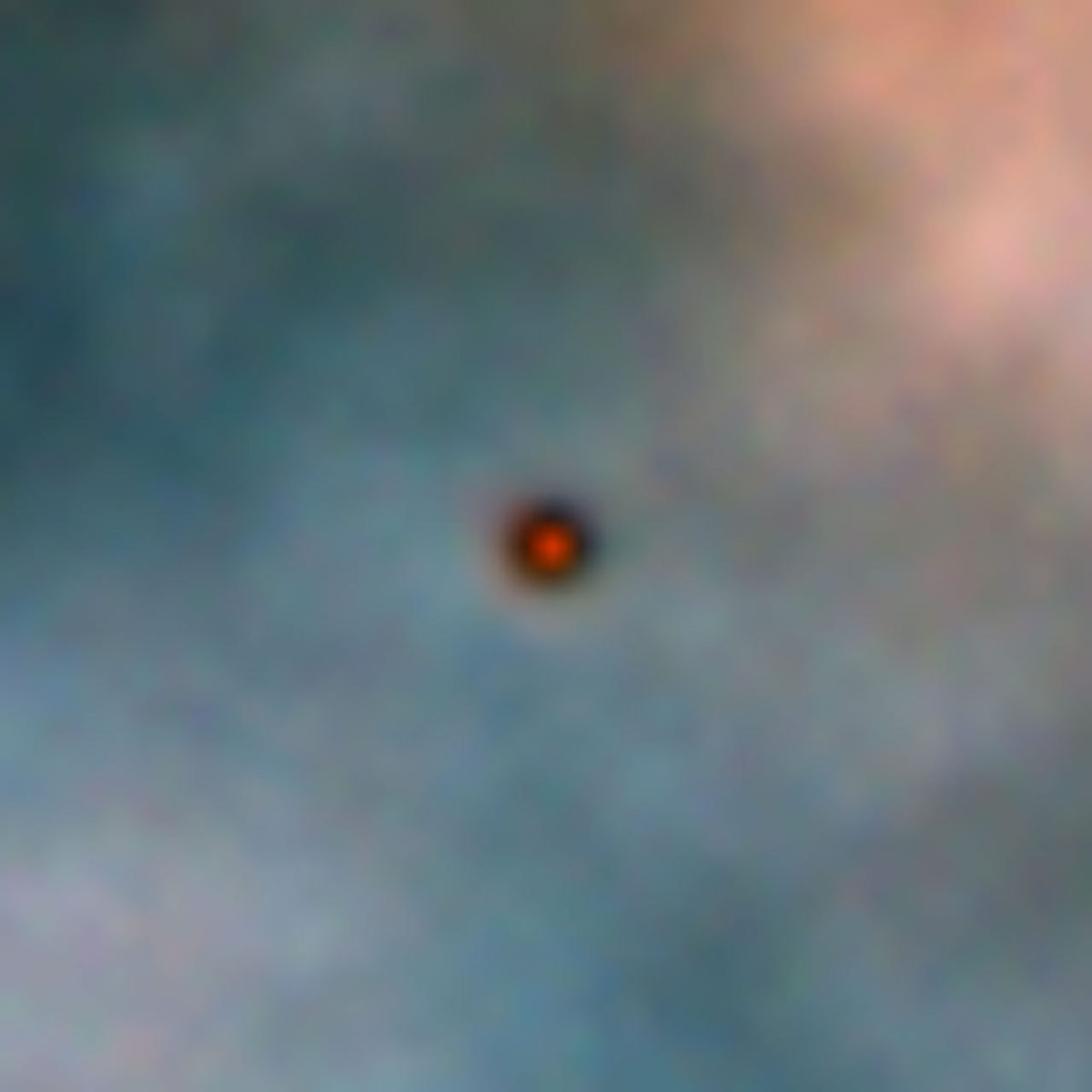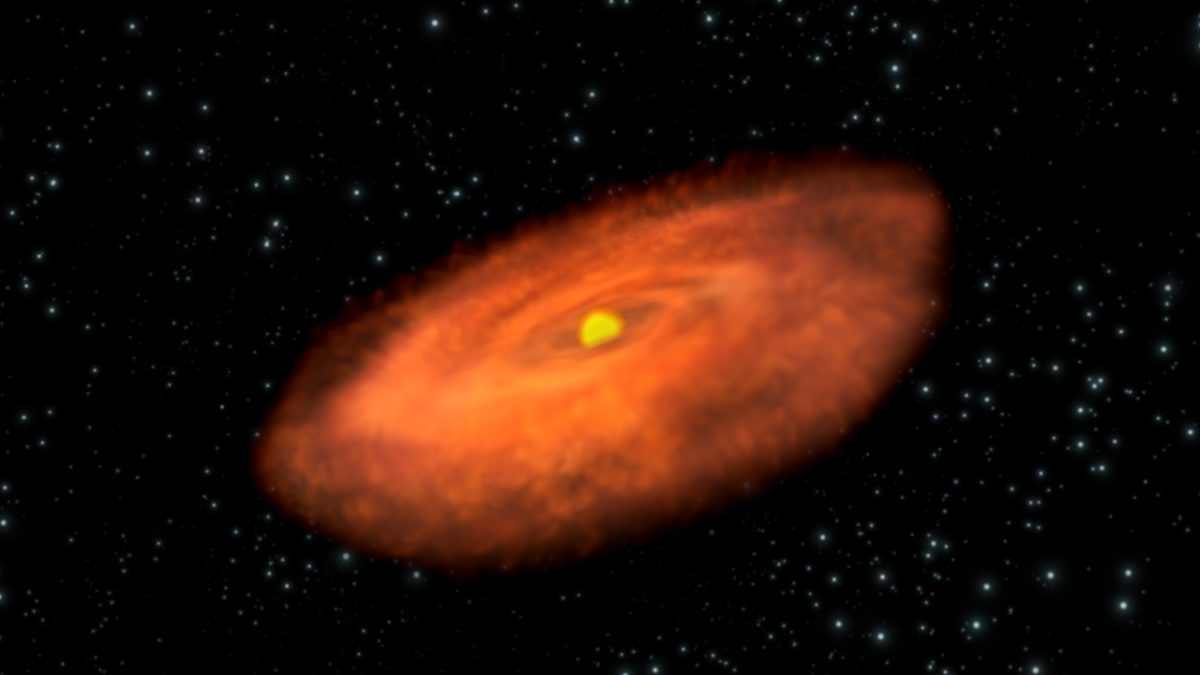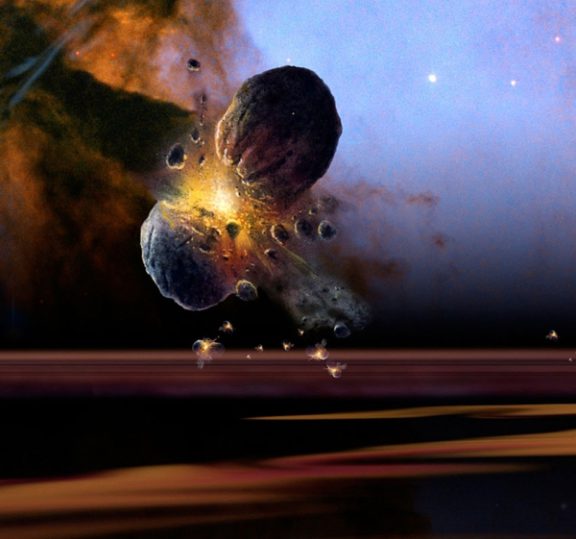Augusto Carballido • Apr 16, 2014
The Birth of the Wanderers
How did planets originate? This is a question that has puzzled scientists for centuries, but one which they have been able to tackle directly only in the last few decades, thanks to two major developments: breakthroughs in telescope technology and ever-increasing computing power. The former has made possible to uncover the existence of almost 1800 planets (as of today) in our galaxy, the attributes of which go beyond our wildest expectations, while the latter has enabled astrophysicists to perform complex calculations to better understand the evolution of planets in general, including their formation.
Any discussion of the formation of planets needs to include protoplanetary disks, which are donut-shaped, gaseous structures that surround a newly-formed star during the first few million years of its evolution, and which deposit their gas on the star's surface at different rates. A star forms, in turn, from the gravitational collapse of huge structures of gas called molecular clouds, which can have enough material to produce multiple stars. Disks are the real main characters of the planet formation story, or the "most valuable player," if you like sports analogies. They are, in effect, planet nurseries.

The properties of protoplanetary disks are closely tied to the star-forming environment in which they are created. Understanding this environment can therefore tell us a great deal about which disk features are most likely to occur whenever a young star is born. That is part of the work done by Joel Green, a research associate at the University of Texas at Austin's Department of Astronomy. Dr. Green uses data from the European Space Agency's Herschel space telescope to determine, among other things, the chemical composition of young stellar objects, as astronomers refer to them. In this way, we can infer which ingredients are available for planets to form around them.
"The goal of planet formation theory is to predict the kinds of planets and systems that will form, given the initial conditions within a protoplanetary disk," says Dr. Green. "Are the initial conditions in a disk inherited from the initial conditions in the molecular cloud that gave birth to the protoplanetary system? Or is the disk composition set instead by chaotic burst accretion events early in the history of the formation of the star?" The "chaotic burst accretion events" to which Dr. Green is referring are episodic phenomena during which a young stellar object's luminosity increases substantially in a relatively short time, likely due to an increase of gas infall onto the star.

One of the most significant pieces of information obtained from astronomical observations of protoplanetary disks is the presence of dust. Dust is the raw material from which planets form. The smallest dust particles that are detected in disks have a size of the order of one micron or less (that is, one-millionth of a meter, or smaller than the width of a human hair). In order to form a planet the size of Jupiter, say, the tiny dust specks will need to interact with each other and with the disk itself through a combination of complex physical and chemical mechanisms. The resulting growth is unparalleled in nature: 14 orders of magnitude in size. That's a factor of 100 trillion!
Inside a protoplanetary disk, the micron-sized particles are small enough that even the disk gas molecules can alter their trajectories by collisions, in a process known as Brownian motion. As a result, the dust particles collide with one another, and in most cases they will stick together through an adhesive mechanism called van der Waals interaction, which operates at the molecular level. The dust will thus form coagulates of different shapes, and this occurs in a very short time for cosmic standards, "only" dozens of years.
Once particles have grown to sizes above several microns, other types of effects begin to dominate the collision process. They are related to the large-scale structure of the protoplanetary disk, and involve the macroscopic motion of the disk gas. This is where one of the most crucial elements of the planet formation process enters, one familiar to air travelers: turbulence. The disk gas not only revolves around the central star in almost-circular orbits, but it also moves in chaotic ways at different length scales. Unlike turbulence in Earth's atmosphere, however, the turbulent motions in a protoplanetary disk are most likely produced by the presence of magnetic fields, which "attach" themselves to parcels of gas that rotate around the star at different speeds and which contain electrical charges, such as electrons and different kinds of ions. The different rotational speeds of the gas parcels to which the magnetic field lines are attached make the lines stretch, to the point of "snapping." This causes the gas to become turbulent.
Growth of solids continues because the particles are aerodynamically coupled to the turbulent gas, and turbulence is a big contributor to particle impacts. Computer simulations show that turbulence can concentrate dust particles in localized regions of a disk long enough for significant collisional growth to occur, essentially through electrostatic forces that depend on the mineralogical composition and structure of the colliding aggregates. This stage of growth, in which millimeter- to centimeter-sized pebbles are formed, can last several hundreds to thousands of years.
It is believed that direct evidence of the turbulent accumulation of pre-planetary material in the disk that formed our own solar system can be seen in a certain type of meteorites, called chondrites. They derive their name from millimeter-sized, marble-like components called chondrules, which are embedded within the meteorite (think of raisins inside a cake). These chondrules, the origin of which is a fascinating and as-yet unsolved problem in itself, are just the right size to achieve large concentrations of material due to turbulence in the early solar system, as many mathematical models have shown.
During the late 1990s, astrophysicists discovered, to their amazement, that not all regions inside a protoplanetary disk are turbulent. Physical calculations that have been corroborated consistently by computer simulations indicate that, the closer the disk gas is to the mid-plane (that is, a horizontal plane that divides the disk in roughly equal halves), the less likely it is for magnetic fields to attach themselves to the gas, because there are not enough electrical charges. The reason is relatively simple: there are many more gas molecules in a unit volume close to the mid-plane than in the outer layers, and those molecules create a "shield" against ionizing radiation that otherwise has no problem stripping electrons away from loner molecules in the outer layers. No free charges, no magnetic field to stretch to the breaking point, and hence no turbulence. Planet formation experts call the turbulence-free region of a disk the "dead zone."

So, turbulence in the outermost layers assists in concentrating particles, and the particles stick and grow in size and mass. In doing this, they become heavier and more susceptible to be pulled towards the mid-plane by the "vertically-pointing" portion of the central star's gravity field. As a result, they start to rain out towards the mid-plane, traveling the height of the dead zone. This settling can last about ten thousand years (we are talking about distances of millions of kilometers), and it creates an opportunity for even more collisions and growth.
What happens next has been somewhat of a puzzle for astrophysicists, who call the following scenario the "meter-size barrier": once the solids reach sizes of about one meter, they are not dragged around by the disk gas as much, but instead feel a tug from the "centrally-pointing" portion of the star's gravity, and the result is that they drift towards the star and vaporize in a relatively short time, about 100 years. In other words, a protoplanetary disk would quickly run out of pre-planetary boulders, leaving no material to form asteroids, moons, or planets. But of course we know that is not generally the case, since we can observe planets by the thousands. So there must be a way to cross the meter-size barrier and assemble larger bodies.
It turns out that gravity comes to the rescue: if there are high enough concentrations of boulders, the mass contained in those concentrations will be such that gravity will take over and assemble planetesimals, as kilometer-size objects are known. One of the most active lines of research in planet formation is the identification of suitable sites in a disk where this gravitational assemblage can occur.
From this point on, the rules of the game change appreciably, and the gravitational force between pairs of planetesimals becomes the main driver of growth. The disk gas only has a modest effect on the motion of the planetesimals, and the physical problem of solid-body accumulation is more tractable. It is still, however, computationally challenging. For example, in order to describe the formation of Mercury, Venus, the Earth and Mars all together, with bodies of approximately 5 kilometers as the raw material, a computer would need to track some 4 billion planetesimals and their mutual gravitational interactions, by all accounts an infeasible task. But astrophysicists can simplify the problem by using a statistical approach to describe this stage of planet formation, and only when the number of bodies drops to a more manageable quantity (after they have grown to a size of tens or even hundreds of kilometers), like a few thousand, can direct computer simulations be used to follow the behavior of the new protoplanets, that is, the direct precursors of planets.
The gravity-dominated stage of planet formation, in which planetesimals smash into each other to form larger objects, would be a great spectacle if we were able to observe at least part of it. Lasting hundreds of thousands of years, it is a cosmic billiard table in three dimensions in which the collision energies can break apart bodies of even 100 kilometers in size! In general, there are three possible outcomes of a collision between two solid bodies: accretion (the smaller body becomes part of the mass of the final body); shattering (the impact breaks up the target body, but the pieces remain relatively close to each other, in a rubble pile); and dispersal (the break-up is total and the resulting pieces fly away). Which of these takes place depends on a variety of factors, including the composition of the colliding bodies (whether they are made of rock or ice, for example), the collision velocity, and the collision angle.
The first type of planets to form are the so-called terrestrial planets, which are those rocky planets that resemble Earth in size. They are the result of the rapid growth of a small fraction of planetesimals that end up sweeping up most of the solid material available to them, forming objects of thousands of kilometers in size in a time of several million years. Since these newly-formed planets are the biggest guys around, their gravitational influence on one another and on the remaining planetesimals creates a chaotic dance that can lead to more impacts, and even alter considerably the orbits of the smaller bodies.
But the formation process continues. We know that there are planets quite larger than Earth, both in our solar system and around other stars. We also know that the giant planets in our solar system, particularly Jupiter and Saturn, have a very thick gas atmosphere which, we think, makes up the bulk of their size. Where did that atmosphere come from? One important piece of the puzzle is the gas of the protoplanetary disk. Could it be that part of the disk gas somehow ends up forming the giant planets' atmospheres?
The computer models tell us that is indeed the case. If an object with a mass similar to Earth's continues to grow and reaches a critical mass of approximately 10 times the mass of Earth, it will trigger a reaction on the surrounding gas that will set off a rapid flux of gas towards the massive core, as the 10-Earth-mass object is known in this context. The core will sweep up gas as it travels in its orbit around the central star. This could go on for another hundred thousand years, give or take. Gas sweep-up will terminate either because the protoplanetary disk gas has dissipated (the gaseous component of a protoplanetary disk does not last forever; it disperses in a few million years), or because the planetary core has opened up a local gap in the disk, like when you try to scoop snow during a snow storm. Either way, this introduces an important constraint into the problem: a giant planet has to form before its parent protoplanetary disk dissipates, or else there will be no gas to form a giant atmosphere.
This is generally how Jupiter and Saturn, and the giant extrasolar planets, are thought to have formed. However, there are still numerous questions that remain unanswered, many of them as a result of recent observations. For example, Adam Kraus, an assistant professor at UT-Austin, has led a collaborative project to identify what could very well be giant planets orbiting their stars at incredibly large distances, up to 300 times the distance between the Earth and the Sun. The mean Sun-Earth distance is known as one astronomical unit, or AU. For comparison, in our solar system the distance between Jupiter and the Sun is 5.2 AU, and the distance between the Sun and the outermost planet, Neptune, is 30 AU. The position of the objects that Prof. Kraus and his team have studied, in relation to their respective stars, pose a challenge to current models of planet formation. How can planets as massive as about 10 Jupiters end up so far away from their central stars? More measurements of these and any as-yet undiscovered similar systems will be required in order to understand their origin.
We are only beginning to fathom the complex mechanisms that are responsible for the origin of planets. This brief overview included some of the most general aspects of what is currently known, but there are many intriguing details that would each require a post of their own. The role of asteroids in delivering water to the early Earth, the formation of the Moon, free-floating planets, and perhaps most captivating of all, the existence of Earth-like planets that could sustain life, are just some of the hottest problems in astrophysics right now. One thing is for certain, though: unraveling the mysteries of planet formation will give us a better idea of how life arose on our own planet.
Let’s Go Beyond The Horizon
Every success in space exploration is the result of the community of space enthusiasts, like you, who believe it is important. You can help usher in the next great era of space exploration with your gift today.
Donate Today

 Explore Worlds
Explore Worlds Find Life
Find Life Defend Earth
Defend Earth




